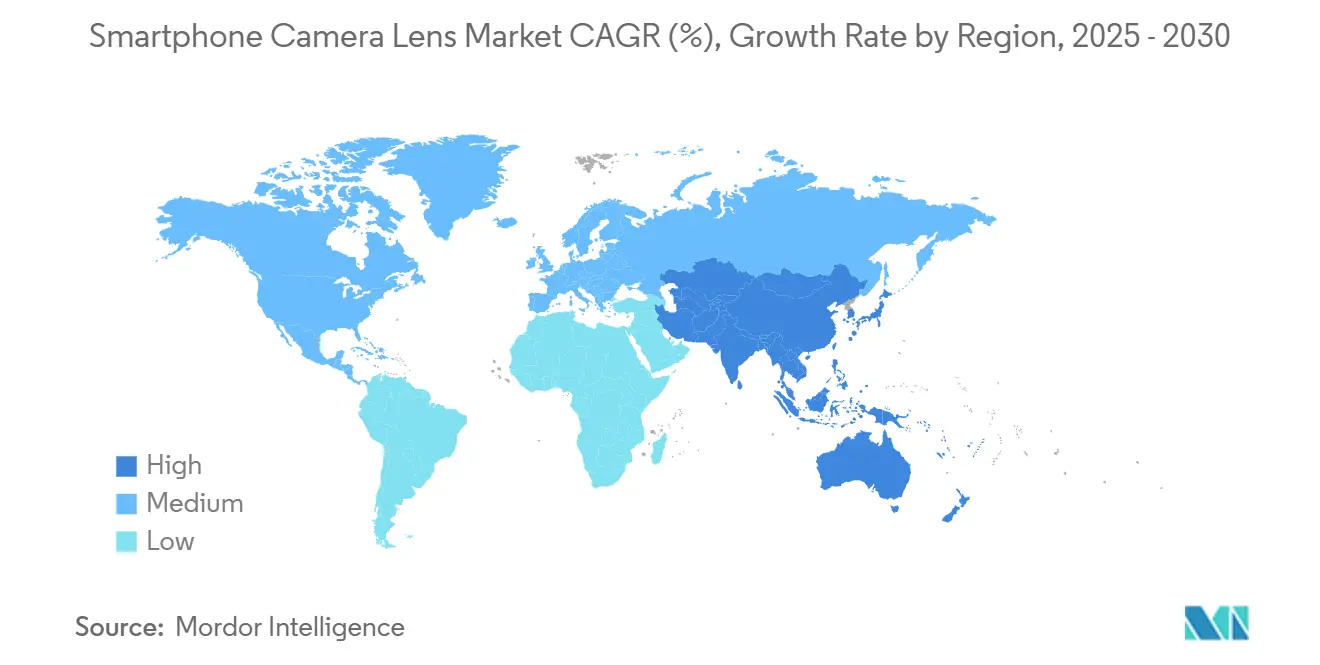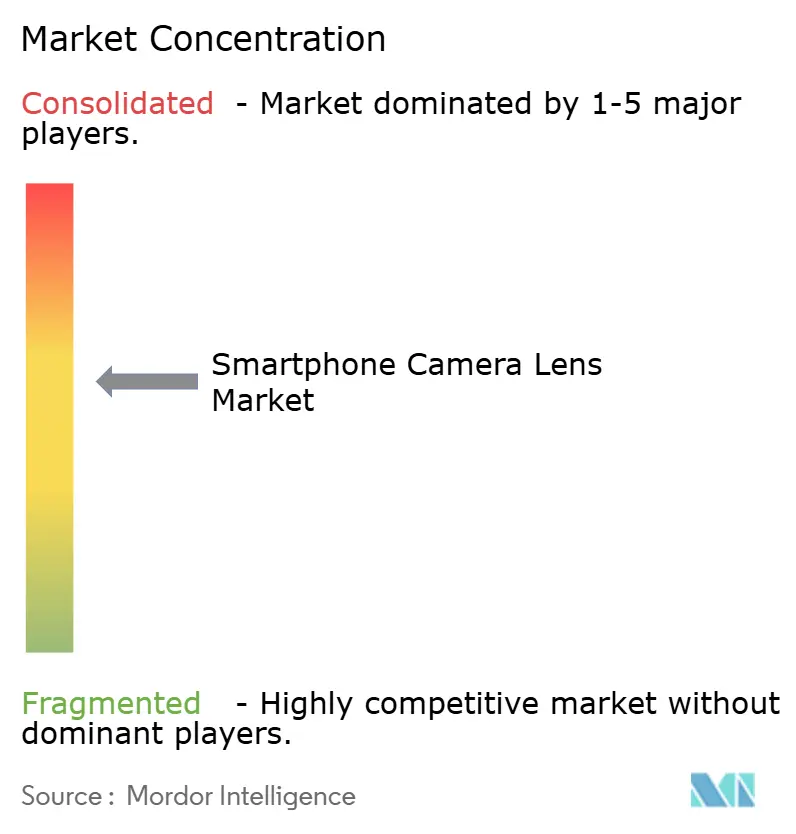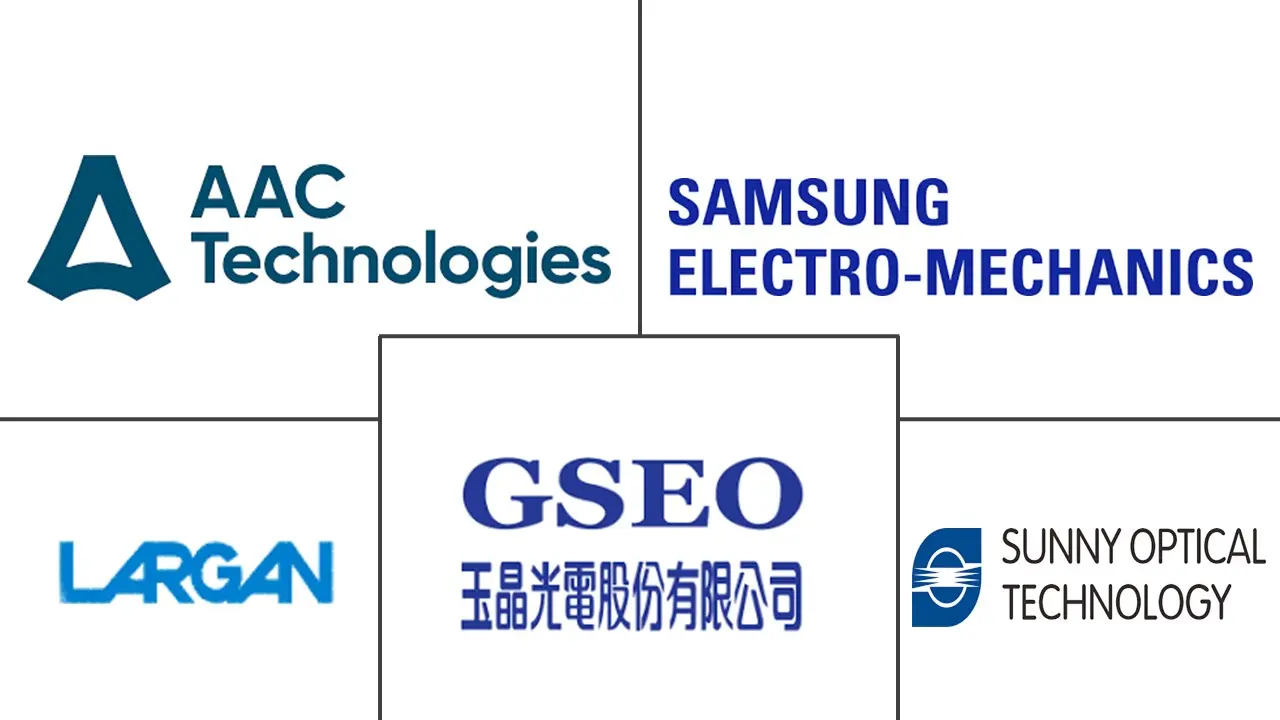
Smartphone Camera Lens Market Analysis by Mordor Intelligence
The smartphone camera lens market size is estimated to be USD 5.43 billion in 2025 and is projected to reach USD 8.04 billion by 2030, growing at an 8.17% CAGR over the forecast period. Consistent demand for optical innovation rather than a simple megapixel race now underpins growth as computational photography, periscope zoom, and premium-tier handset adoption converge. The smartphone camera lens market benefits from the rapid mainstreaming of periscope modules, which deliver 5×-10× optical zoom while maintaining thin profiles, a feature amplified by flagship launches across the Asia-Pacific. Manufacturers also prioritize glass-plastic hybrids to strike a balance between cost and optical performance, enabling the smartphone camera lens market to serve both budget and premium lines without compromising quality. Elevated average selling prices (ASPs) flow from 50 MP-plus sensors and AI-optimized image pipelines, strengthening revenue even as global smartphone shipments plateau. Supply-chain relocation to India and Vietnam, incentivized through production-linked incentives, further anchors the medium-term resilience of the smartphone camera lens market.
Key Report Takeaways
- By lens technology, wide/primary assemblies held 58.1% of the smartphone camera lens market share in 2024; telephoto modules, including periscope variants, are projected to post a 9.7% CAGR through 2030.
- By material, all-glass products accounted for 44.1% of the smartphone camera lens market size in 2024, while glass-plastic hybrids are projected to advance at a 10.0% CAGR through 2030.
- By camera position, rear-secondary units captured 35.7% of shipments in 2024 and are projected to track a 9.9% CAGR to 2030, reflecting the proliferation of multi-camera systems.
- By geography, the Asia-Pacific region dominated with a 48.30% smartphone camera lens market share in 2024; it is on course for a 10.13% CAGR as local manufacturing scales.
Global Smartphone Camera Lens Market Trends and Insights
Drivers Impact Analysis
| DRIVER | (~) % IMPACT ON CAGR FORECAST | GEOGRAPHIC RELEVANCE | IMPACT TIMELINE |
|---|---|---|---|
| Proliferation of multi-camera smartphones | +2.1% | Global (Asia-Pacific leading) | Medium term (2-4 years) |
| Megapixel race above 50 MP | +1.8% | North America and Europe premium tiers | Short term (≤ 2 years) |
| Rapid adoption of periscope/telephoto modules | +2.3% | Asia-Pacific core; expanding worldwide | Medium term (2-4 years) |
| AI-centric computational photography | +1.5% | Global, concentrated in flagship devices | Long term (≥ 4 years) |
| Localized supply-chain build-out | +0.7% | India and Vietnam | Long term (≥ 4 years) |
| Glass-plastic free-form lenses | +0.3% | Premium foldables and wearables | Long term (≥ 4 years) |
| Source: Mordor Intelligence | |||
Proliferation of Multi-Camera Smartphones
Triple- and quad-camera arrays have moved from premium novelties to mainstream fixtures, now standard above the USD 200 price band. Oppo’s Find X7 Ultra illustrates the momentum, debuting twin periscope lenses that cover 72 mm and 135 mm focal lengths, a specification that narrowed the zoom gap against DSLRs.[1]Source: Ben Sin, “Oppo Find X7 Ultra Review,” scmp.com Lens volumes rise in tandem with these architectures, and ASPs stay elevated because each additional module relies on dedicated optics, actuators, and coatings. Multi-sensor layouts also unlock computational features such as depth mapping and real-time face deblurring, showcased by Google’s Pixel 6 dual-camera fusion system. The smartphone camera lens market, therefore, enjoys a unit-plus-value windfall while OEMs use multi-camera specs as a countertop differentiator in saturated handset segments.
Megapixel Race Above 50 MP Lifting Lens ASPs
Sensor vendors have surpassed the 50 MP threshold and are now piloting 200 MP telephoto designs that require precise optics, stringent tolerances, and enhanced stabilization.[2]Source: Samsung Semiconductor, “Ultra-High Resolution 200 MP Telephoto Cameras,” semiconductor.samsung.com For lens makers, every increase in pixel density tightens surface-shape specifications and assembly alignment, thereby inflating per-unit pricing. Largan Precision’s high-end (>20 MP) shipments climbed to 20-30% of volume in 2025, pushing margins upward even before full 200 MP commercialization. Yet diminishing returns in raw resolution channel attention toward AI-driven image processing, prompting lens houses to pair glass quality with data-rich capture characteristics.
Rapid Adoption of Periscope and Telephoto Modules
Folded-optics stacks deliver 5×-10× true optical zoom without thickening handset bodies. Adoption accelerated after leading brands integrated tetraprism setups, and suppliers such as LG Innotek committed USD 1 billion to double Vietnamese capacity to meet demand. Manufacturing complexity, from prism alignment to thermal control, keeps barriers high, allowing established Asian suppliers to retain pricing power. Cost-optimized variants are emerging for mid-range devices, but premium handsets still command the lion’s share, as consumers prioritize zoom quality over chipset specs.
AI-Centric Computational Photography Requirements
Edge AI chipsets now ship inside more than half of flagship smartphones, placing fresh optical constraints on lens stacks.[3]Source: Rafie Manouchehr, “AI-Powered Camera Sensors,” wileyindustrynews.com Algorithms that handle HDR fusion, super-resolution, and low-light noise suppression need lenses with low distortion and uniform light transmission. The smartphone camera lens market is shifting toward designs that complement AI processing, favoring wider apertures, minimized chromatic aberration, and coatings that suppress flare. Samsung’s achromatic metalens collaboration with POSTECH, which eliminates chromatic drift in a 30 µm ultra-thin layer, underscores this hardware-plus-software convergence.
Restraints Impact Analysis
| RESTRAINTS | (~) % IMPACT ON CAGR FORECAST | GEOGRAPHIC RELEVANCE | IMPACT TIMELINE |
|---|---|---|---|
| Global smartphone unit saturation | -1.9% | North America, Europe, developed Asia-Pacific | Short term (≤ 2 years) |
| Aggressive pricing pressure in mid-/low tiers | -1.2% | Emerging markets | Medium term (2-4 years) |
| High-layer hybrid lens yield challenges | -0.8% | China, Taiwan, South Korea manufacturing hubs | Medium term (2-4 years) |
| Export-control risk on glass-molding tools | -0.5% | China | Long term (≥ 4 years) |
| Source: Mordor Intelligence | |||
Global Smartphone Unit Saturation
Shipment volumes slipped in 2023, as consumers held devices for 3–4 years and deferred upgrades amid economic uncertainty.[4]Source: Jie Yang & Sarah Donaldson, “Consumers Keep Phones Longer,” wsj.com Mature regions struggle to justify new purchases on camera specs alone, damping base-level lens demand even as premium segments remain resilient. Aspirational buyers are increasingly choosing refurbished flagships, thereby shrinking the entry-level segment where low-cost plastic optics once dominated. For lens suppliers, diversification into automotive ADAS modules and AR/VR displays becomes crucial to offset the plateau in handset volumes.
Aggressive Pricing Pressure in Mid-/Low-Tier Handsets
OEMs demand optics that achieve acceptable image quality at increasingly lower price points, forcing the adoption of glass-plastic hybrids, automation, and yield optimization. Smaller suppliers, lacking scale, risk margin erosion or exit, while high-volume incumbents leverage process control to maintain their market presence. The smartphone camera lens market consequently bifurcates: premium lines sustain ASPs, but price compression pressures the mass segment.
Segment Analysis
By Lens Technology: Telephoto Modules Drive Premium Shift
Telephoto assemblies, including periscope architectures, are forecast to post the highest 9.7% CAGR, redefining zoom expectations as consumers equate optical reach with flagship quality. In 2024, wide/primary lenses captured 58.1% of the volumes, emphasizing their ubiquity across all tiers and serving as the benchmark for comparative performance. However, telephoto demand delivers a larger revenue slice because multi-element stacks, precision prisms, and actuator coils lift BOM value.
Complementary ultra-wide modules meet social media content needs, offering creative field-of-view flexibility, although growth remains moderate. Macro and depth sensors often appear in quad-camera checklists but contribute marginal utility, prompting certain OEMs to drop them for higher-quality dual setups. Industry innovation centers on variable-aperture telephoto hybrids, promises of 8× continuous optical zoom, and AI-assisted computational zoom that stitches multiple frames. Together, these factors ensure that the smartphone camera lens market continues to focus resources on telephoto research and development, where perceived user value remains highest.

Note: Segment shares of all individual segments available upon report purchase
By Lens Material: Hybrid Solutions Balance Performance and Cost
All-glass lenses retained a 44.1% revenue share in 2024, dominating premium flagships that prioritize clarity, thermal stability, and color fidelity. The smartphone camera lens market share for hybrids, however, is expanding at the fastest rate, with 10.0% CAGR forecasts reflecting OEM cost-control mandates. Glass-plastic combinations reduce weight and BOM cost but introduce challenges, namely differing coefficients of thermal expansion and stricter molding precision requirements. Simulation studies suggest a ten-fold precision bump could push acceptable yield rates to 60% on hybrid stacks, encouraging process innovation.
Wafer-scale molding now enables the simultaneous formation of dozens of micro-lenses, reducing energy consumption by up to 80% compared to conventional single-mold processes. Suppliers capitalizing on these gains realign capacity toward hybrid optics that satisfy mid-range ASP ceilings without overtly compromising image quality. Consequently, the smartphone camera lens market size for hybrids may surpass that of all-glass units in shipment terms by 2030, even as glass maintains a performance halo in the flagship space.
By Camera Position: Multi-Camera Systems Reshape Demand Dynamics
Rear-secondary modules housing ultra-wide, telephoto, or spectral sensors are growing at 9.9% CAGR, reflecting their role in differentiation. The smartphone camera lens market thus channels capital expenditure toward secondary-camera assembly lines equipped for folded optics and wider apertures. Rear-primary units still account for 35.7% of demand, but plateauing handset volumes temper incremental growth. Front-facing modules show slower expansion given limited bezel space and OEM inclination to allocate camera budgets to more visible rear stacks.
Investment patterns echo this shift: LG Innotek’s USD 1 billion Vietnam expansion concentrates on multi-camera configurations, anticipating OEM appetite for four-camera platforms. Software fusion continues to strengthen rear-secondary relevance Google’s dual-camera de-blurring algorithm mines data from paired lenses for crisp low-light portraits.[5]Source: Wei-Sheng Lai et al., “Face Deblurring Using Dual Cameras,” arxiv.org These factors keep the smartphone camera lens market firmly oriented toward versatile rear assemblies, cementing them as the nexus of future optical innovation.

Note: Segment shares of all individual segments available upon report purchase
Geography Analysis
Asia-Pacific captured a 48.30% smartphone camera lens market share in 2024, mirroring its dominance in handset assembly. China remains foundational due to its entrenched supply ecosystems, yet rising labor costs and export controls are propelling diversification. India’s production-linked incentives propelled it to 20% of the worldwide smartphone output by 2025, with domestic sourcing breakthroughs reducing import dependence to 1%. Vietnam, buoyed by investments from LG Innotek and Samsung Electro-Mechanics, has become an indispensable node for folded-optic fabrication.
North America and Europe focus on premium-tier consumption and research and development, fostering close collaboration between chipset designers and optical houses. Investments in AI-centric image pipelines fuel demand for high-precision lenses that meet algorithmic thresholds. Conversely, Latin America and the Middle East witness gradual smartphone penetration, offering long-tail volume opportunities, albeit at tighter margins. Geopolitical uncertainties encourage OEMs to pursue a “China-plus-two” footprint, dispersing smartphone camera lens market risk across multiple Asia-Pacific jurisdictions.

Competitive Landscape
Taiwanese and Chinese suppliers command a significant share of global output, indicating a high level of concentration; however, competition intensifies as localization and technological disruption reshape the field. Largan Precision, buoyed by superior plastic-aspheric capabilities, reported a 31% revenue surge in July 2025 and its strongest Q1 EPS in five years. The smartphone camera lens market also features vertically integrated conglomerates, such as Samsung Electro-Mechanics and LG Innotek, which leverage module know-how to court automotive and robotics camera contracts, stretching their advantage beyond handsets.
Technological differentiation shapes rivalry: Samsung’s achromatic metalens breakthrough promises thinner, aberration-free stacks, while ETH Zurich’s lithium-niobate metasurfaces convert IR to visible wavelengths, hinting at spectrally agile optics. Patent portfolios and capital intensity pose significant barriers for new entrants, yet niche players are emerging in the foldable device optics and AR/VR headset markets. Over the assessment window, the smartphone camera lens industry is likely to see selective mergers and acquisitions as incumbents acquire specialty startups to hedge against disruptive advances.
Smartphone Camera Lens Industry Leaders
-
Largan Precision Co. Ltd.
-
Sunny Optical Technology (Group) Co. Ltd.
-
Samsung Electro-Mechanics Co. Ltd.
-
Genius Electronic Optical Co. Ltd.
-
AAC Technologies Holdings Inc.
- *Disclaimer: Major Players sorted in no particular order

Recent Industry Developments
- August 2025: VisEra Technologies expanded its Longtan plant to serve thin-form optics for AI glasses and smartphones, aligning with CIS demand upturn.
- June 2025: Genius Electronic Optical projected stronger H2 orders on premium handset launches and rising periscope adoption.
- June 2025: ETH Zurich revealed lithium-niobate metalenses that halve incident wavelengths, a development poised to slim future smartphone optics.
- March 2025: Xiaomi and Realme showcased concept phones with interchangeable or magnetic DSLR-grade lenses at MWC 2025, underscoring modular-photography interest.
Global Smartphone Camera Lens Market Report Scope
| Wide/Primary (≤26 mm) |
| Ultra-Wide |
| Telephoto (Incl. Periscope) |
| Macro/Depth |
| All-Glass |
| All-Plastic |
| Glass-Plastic Hybrid |
| Rear-Primary |
| Rear-Secondary (Ultra-Wide/Tele) |
| Front/Facing |
| North America | United States | |
| Canada | ||
| Mexico | ||
| South America | Brazil | |
| Argentina | ||
| Rest of South America | ||
| Europe | Germany | |
| United Kingdom | ||
| France | ||
| Russia | ||
| Rest of Europe | ||
| Asia-Pacific | China | |
| Japan | ||
| India | ||
| South Korea | ||
| Rest of Asia-Pacific | ||
| Middle East and Africa | Middle East | Saudi Arabia |
| United Arab Emirates | ||
| Rest of Middle East | ||
| Africa | South Africa | |
| Egypt | ||
| Rest of Africa | ||
| By Lens Technology | Wide/Primary (≤26 mm) | ||
| Ultra-Wide | |||
| Telephoto (Incl. Periscope) | |||
| Macro/Depth | |||
| By Lens Material | All-Glass | ||
| All-Plastic | |||
| Glass-Plastic Hybrid | |||
| By Camera Position | Rear-Primary | ||
| Rear-Secondary (Ultra-Wide/Tele) | |||
| Front/Facing | |||
| By Geography | North America | United States | |
| Canada | |||
| Mexico | |||
| South America | Brazil | ||
| Argentina | |||
| Rest of South America | |||
| Europe | Germany | ||
| United Kingdom | |||
| France | |||
| Russia | |||
| Rest of Europe | |||
| Asia-Pacific | China | ||
| Japan | |||
| India | |||
| South Korea | |||
| Rest of Asia-Pacific | |||
| Middle East and Africa | Middle East | Saudi Arabia | |
| United Arab Emirates | |||
| Rest of Middle East | |||
| Africa | South Africa | ||
| Egypt | |||
| Rest of Africa | |||
Key Questions Answered in the Report
How large is the global smartphone camera lens opportunity today?
It is valued at USD 5.43 billion in 2025 and is projected to reach USD 8.04 billion by 2030.
What is the expected compound annual growth rate for smartphone camera lenses through 2030?
The segment is projected to grow at an 8.17% CAGR from 2025 to 2030.
Which region leads unit production and revenue for smartphone camera lenses?
Asia-Pacific holds 48.30% share and is advancing at a 10.13% CAGR.
Which lens type is growing fastest in smartphones?
Telephoto assemblies, including periscope variants, are pacing the field at a 9.7% CAGR.
Page last updated on:



